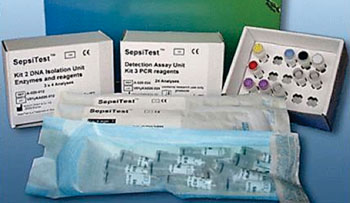Direct Molecular Detection of Bloodstream Infection Evaluated
By LabMedica International staff writers
Posted on 02 Aug 2016
Blood culture is the current gold standard for detecting bacteria in blood, requires at least 24 to 48 hours and has limited sensitivity if obtained during antibiotic treatment of the patient. Severe sepsis is sepsis associated with organ dysfunction, hypoperfusion, or hypotension.Posted on 02 Aug 2016
Rapid diagnosis and appropriate antimicrobial therapy are of major importance to decrease morbidity and mortality in patients with blood stream infections (BSI). Sepsis, severe sepsis and septic shock are associated with high mortality, ranging from 20% to 60 % depending on severity and underlying disease. Septic shock is the persistence of hypotension and perfusion abnormalities despite adequate resuscitation therapy.

Image: The SepsiTest allows the reliable molecular analysis of whole blood samples for bacteremia and fungemia (Photo courtesy of Molzym).
Scientists led by those at VU University Medical Center (Amsterdam, The Netherlands) carried out a prospective multicenter study to clinically evaluate the application of a commercial universal molecular test directly on whole blood. In total 236 samples from 166 patients with suspected sepsis were included in the study. The molecular test results were compared to blood culture, the current gold standard for detecting BSI. Because blood cultures can give false-negative results, the team performed an additional analysis to interpret the likelihood of bloodstream infection by using an evaluation based on clinical diagnosis, other diagnostic tests and laboratory parameters.
Fresh EDTA blood was divided into two aliquots of 1 mL and processed according to the SepsiTest protocol (PCR-ST, Molzym, Bremen, Germany). The SepsiTest assay selectively degrades human DNA, before isolation of the microbial DNA. SepsiTest can provide a positive or negative result within four hours and needs additional sequencing to identify the microorganism, which takes another two to three hours if sequencing is available in the laboratory.
The clinical interpretation of results defined the detected organism to be contaminants in 22/43 positive blood cultures (51.2 %) and 21/47 positive PCR-ST results (44.7 %). Excluding these contaminants resulted in an overall sensitivity and specificity of the PCR-ST of 66.7% and 94.4%, respectively. Of the 36 clinically relevant samples, 11 BSI were detected with both techniques, 15 BSI were detected with PCR-ST only and 10 with blood culture only. Therefore, in this study, SepsiTest detected an additional 71 % BSI compared to blood culture alone. The majority of detected microorganisms were staphylococci in both blood culture and PCR-ST.
The authors concluded that overall, PCR-ST results may influence the administration of adequate antimicrobial therapy and diminish patient’s morbidity and mortality. Although the SepsiTest PCR directly on blood is a promising technique, the input volume of blood should be increased to lower sampling error, and a faster procedure to identify the microorganism is of importance. The study was published on June 30, 2016, in the journal BMC Infectious Diseases.
Related Links:
VU University Medical Center
Molzym













